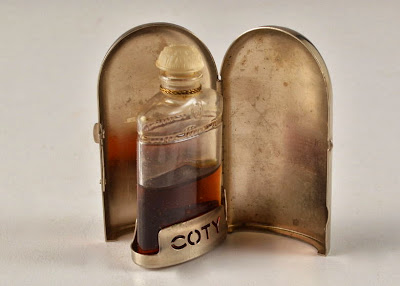Lady Abdy (Iya Grigorievna de Gay) models Cartier 'Pylon' pendant
Vogue, December 1928
Vogue, December 1928
One can stare at Lady Abdy's Egyptian ornaments in Sotheby's upcoming sale only so long before needing some kind of elixir to ward off envy. Researching Lady Abdy led us back to a Cartier event that took place in the firm's New York salon at 712 Fifth Avenue. Pierre Cartier, whose wife was American, perched there for a few years before he acquired the firm's flagship building across the street, famously swapping a strand of pearls for the deed. On 11 November 1913, Messrs. Cartier previewed a 5-days-only exhibit of refitted gems acquired "...from the Hindoo, Persian, Arab, Russian and Chinese..."
One of the 50 pieces exhibited in New York by Cartier in November 1913, shown with the cover of the catalogue
Next door to this grand display of exoticism, at 714 Fifth, shoppers seeking the latest scents from Paris entered beneath a 3-story glass window that Francois Coty commissioned from Rene Lalique, his bottle maker, to dress up the store's facade. Lalique obliged with a vertical cascade of poppies and vines parted like an Ice Queen's drapery by one course of clear panes. No doubt Gustav Manz strolled uptown from his workshop on East 28th to view Cartier's first pieces in the "modern" geometric style. And to gander at those titanic glass garlands catching the light over Fifth Avenue.
At the time, Manz was one of a handful of artisans in New York doing the fine platinum work Cartier's firm would become famous for. His cost books and business correspondence reference sales of his own work to Cartier, and his design inspirations—particularly Egyptian themes—were fed by the same historical sources.
In his early twenties, Manz had visited the Valley of the Kings and made detailed sketches of artifacts in the Cairo museum; his hand-wrought mountings for F. Walter Lawrence's line of ancient glass shards and tear bottles (an early type of vinaigrette) received admiring notice at the National Arts Club exhibit of "Old, Modern, and Oriental" jewels in 1903; many of those gems went on view at the international exposition in St. Louis the next year.
Glass act: Lalique windows over entrance at 714 Fifth Avenue, formerly known as the Coty Buildling (currently occupied by the Henri Bendel department store)
Assorted Egyptian designs by Gustav Manz; hand-carved gold bust mounted on gem from a private collection; scarab and carved gemstone pendant shown at The Metropolitan Museum of Art Eighth Annual Industrial Arts exhibit (Jewelers' Circular, January 30, 1924); Manz drawing, Mathews family collection
In his early twenties, Manz had visited the Valley of the Kings and made detailed sketches of artifacts in the Cairo museum; his hand-wrought mountings for F. Walter Lawrence's line of ancient glass shards and tear bottles (an early type of vinaigrette) received admiring notice at the National Arts Club exhibit of "Old, Modern, and Oriental" jewels in 1903; many of those gems went on view at the international exposition in St. Louis the next year.
In the late 1880s, Manz landed in Paris, where Lalique was making his name. By 1913, he'd established his own New York studio and was selling his revivalist designs to Tiffany, Marcus & Company and merchants in Boston, Philadelphia, and Chicago. As a designer/manufacturer supplying mountings for some of the city's most prestigious jewelry houses, he had privileged access to historic artifacts acquired by the Metropolitan Museum and was adapting those motifs into his pieces. In 1924, Manz would exhibit his pieces alongside Cartier's at the museum's 8th annual industrial art show.
Top: Platinum, gold, diamond, faience and colored stone 'Pylon' brooch, circa 1923, "Property formerly from the estate of Iya, Lady Abdy" (Sotheby's catalog); bottom:
Gustav Manz design for a Pylon-style pendant, circa 1901, Mathews family collection
Cartier has long since moved from No. 712, and the former House of Coty now houses fashion emporium Henri Bendel, now de facto trustee of the window. Coty's gift to the city has given us new respect for vintage perfume decanters offered on eBay, often with desiccated amber residue inside, reminiscent of the ancient tear bottles sought by Gilded Age aesthetes. (More on the history of this fragrant landmark at Daytonian in Manhattan.)
This week, when Lady Abdy's jewels go on the block, we'll make our own pilgrimage to Bendel's for a whiff of Coty's closest successor to Parfum Styx (introduced in 1911) and a close-up look at the windows that just barely escaped the wrecker's ball when a developer seeking to alter the street-scape was sent packing by preservationists in the 1980s. (People discard perfume atomizers and rework old jewelry mountings, but no one throws stones at Lalique.)
This week, when Lady Abdy's jewels go on the block, we'll make our own pilgrimage to Bendel's for a whiff of Coty's closest successor to Parfum Styx (introduced in 1911) and a close-up look at the windows that just barely escaped the wrecker's ball when a developer seeking to alter the street-scape was sent packing by preservationists in the 1980s. (People discard perfume atomizers and rework old jewelry mountings, but no one throws stones at Lalique.)
Coty perfume bottle with Lalique-style topper
in silver travel case, c 1920 (eBay)
Copyright © Laura Mathews, 2014
All Rights Reserved
in silver travel case, c 1920 (eBay)
_________________________________________
Copyright © Laura Mathews, 2014
All Rights Reserved
GUSTAV MANZ LLC
__________________________________________




+%C2%A9+Gustav+Manz+LLc.jpg)






